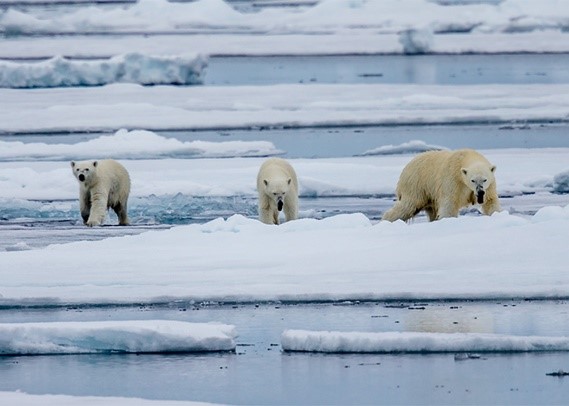RISING TEMPERATURES IN THE ARCTIC

Disclaimer: Copyright infringement not intended.
In News
- Recently, the National Oceanic and Atmospheric Administration’s (NOAA) annual Arctic Report Card was released.
Findings of the Report
- Rising temperatures in the Arctic have led to unprecedented wildfires that forced communities to evacuate, a decline in sea ice extent, devastating floods, food insecurity, and a rise in sea level.
- The 2023 summer was the warmest on record in the Arctic, which, due to climate change, has warmed nearly four times faster than the globe since 1979.
- Overall, the past year was the sixth-warmest year the Arctic had experienced since reliable record-keeping began in 1900.
- The rising temperatures in the northern polar region contributed to unprecedented wildfires that forced communities to evacuate, a decline in sea ice extent, devastating floods, food insecurity, and a rise in sea level, according to the study.
Consequences of the soaring temperatures in the Arctic
- Here is a look at the most severe consequences of the soaring temperatures in the Arctic.
THAWING OF SUBSEA PERMAFROST
- Subsea permafrost is essentially frozen soil beneath the seabed that contains organic matter. While it has been gradually thawing for thousands of years, (now) warmer ocean temperatures are accelerating this process, making it a cause of concern for scientists.
- “Just as with permafrost on land, when subsea permafrost thaws, the organic matter it contains decays and releases methane and carbon dioxide – greenhouse gases that contribute to global warming and worsen ocean acidification.
- To make matters worse, there isn’t enough research to estimate how much greenhouse gases will subsea permafrost release in the following years and what will be its effect on global warming.
FOOD INSECURITY
- Due to the impact of climate change on freshwater bodies and marine ecosystems, Western Alaska recorded another year of extremely low numbers of Chinook and chum salmon — 81% and 92% below the 30-year mean, respectively. The size of adult salmon has also decreased, according to the report.
- It led to “fishery closures, worsened user conflicts, and had profound cultural and food security impacts in Indigenous communities that have been tied to salmon for millennia,” it added.
- Interestingly, while the population of Chinook and chum salmon declined, sockeye salmon increased in number — 98% above the 30-year mean — in Western Alaska.
- The diverging impacts are affecting Indigenous communities that depend on the salmon for food, and challenging fishery managers as the different species respond in unique ways to the warming climate.”
RAGING WILDFIRES
- Canada — 40% of its land mass is considered Arctic and Northern — was among the worst affected regions when it comes to wildfires.
- The country witnessed its worst wildfire season on record with fires burning more than 10 million acres in the Northwest Territories.
- This happened as high temperatures dried up vegetation and soil, coupled with below-average rainfall, creating perfect conditions for wildfires to burn more easily.
- “More than two-thirds of the territories’ population of 46,000 people had to be evacuated at various points and smoke from the fires reached millions more people, reducing air quality as far as the southern United States,” the news outlet added.
- Some areas were 7.2 degrees Fahrenheit or more above average (darkest red). (graph) Summer temperatures (July-September) each year from 1940-2023, showing rapid warming in recent decades.
SEVERE FLOODING
- Rising temperatures have led to dramatic thinning of the Mendenhall Glacier, located in Alaska, over the past 20 years, the NOAA report said. As a result, over the years, the meltaway water has annually caused floods in the region.
- One such disaster took place in August 2023, when “a glacial lake on a tributary of the Mendenhall Glacier burst through its ice dam and caused unprecedented flooding and severe property damage” in Alaska’s Juneau, the study added.
GREENLAND ICE SHEET MELTING
- The NOAA report noted that the highest point on Greenland’s ice sheet experienced melting for only the fifth time in the 34-year record.
- Not only this, the ice sheet continued to lose mass despite above-average winter snow accumulation — between August 2022 and September 2023, it lost roughly 350 trillion pounds of mass.
- Notably, Greenland’s ice sheet melting is the second-largest contributor to sea-level rise.
|
PRACTICE QUESTION Q. Rising temperatures in the Arctic have led to a huge impact on the environment. What are the consequences of the soaring temperatures in the Arctic? |





1.png)
